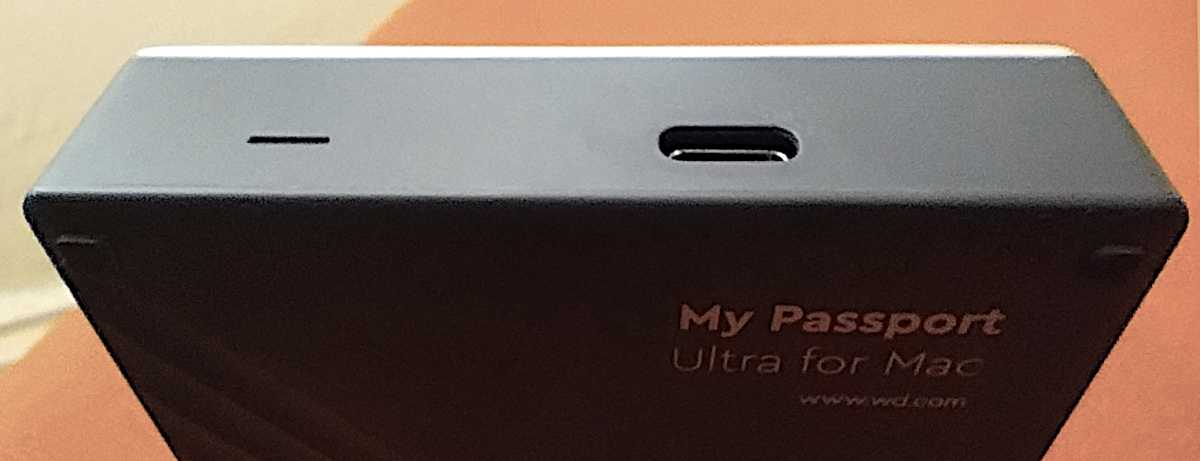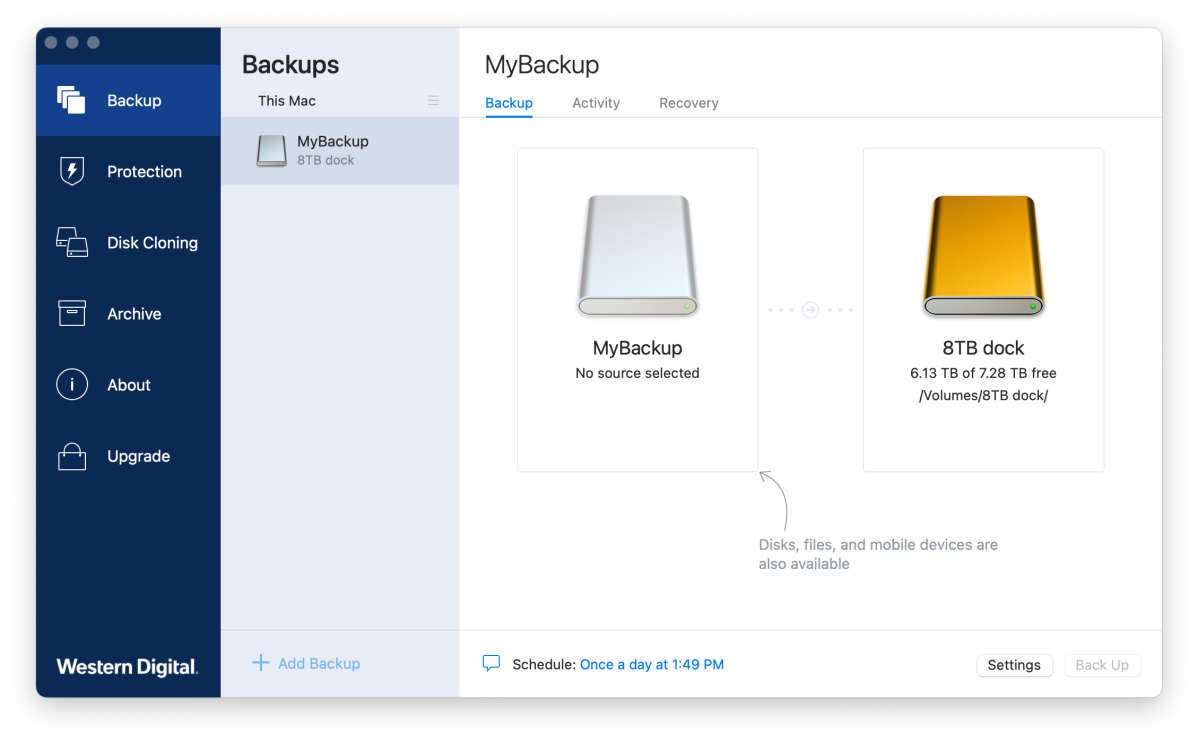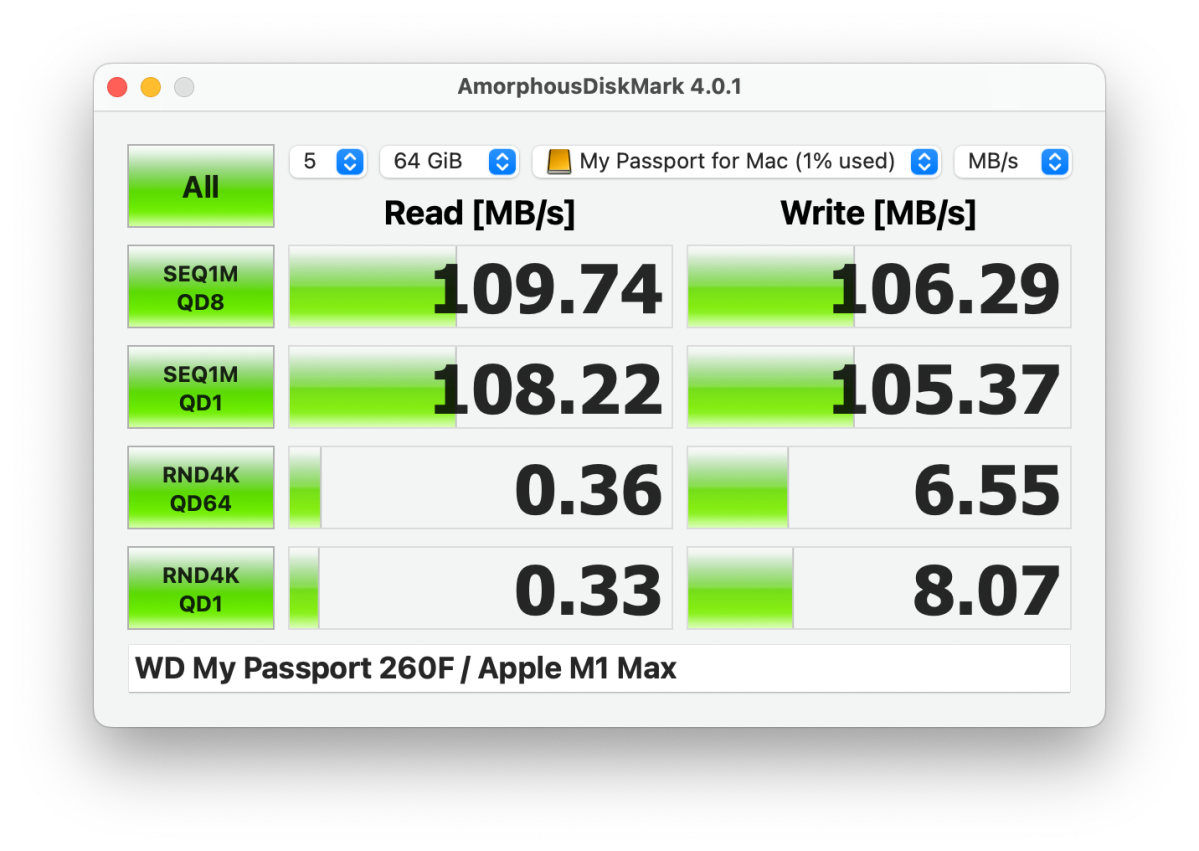Expert’s Rating
Pros
- Up to a whopping 6TB of storage
- Far cheaper per terabyte than SSDs
- Type-C connectivity
- Attractive design fits in your (large) pocket
Cons
- Hard drive-level performance
Our Verdict
WD’s new portable My Passport Ultra for Mac 2.5-inch USB hard drive is available with up to 6TB of storage–for far less cash than any SSD.
Price When Reviewed
$84.99 (2TB), $129.99 (4TB), $139.99 (5TB), $199.99 (6TB)
Best Prices Today: My Passport Ultra for Mac
$79.99
$84.99

$89.99

$89.99
Let’s face it: external portable HDDs such as the WD My Passport Ultra for Mac offer slow speeds by today’s SSD standards. That said, they still provide by far the most storage capacity for the smallest outlay, to the tune of 6TB for only $200 in this case.
As to the performance I referred to at the start of this review, faster is of course better, but the 110MBps reads and writes the My Passport Ultra delivers are fine for media streaming as well as Time Machine backups running in the background. It’ll get the job done.
WD My Passport Ultra for Mac: Features
The My Passport Ultra for Mac (Could we have a longer name, please?) is a 2.5-inch external USB hard drive sporting a USB-C port that’s on the same end as the small power/activity light. The drive enclosure is styled in dark gray and silver and measures approximately 4.3 inches long by 3.2 inches wide by 0.86 inches thick.
Weight is around 8.9 ounces including cable, which, along with four anti-skid pads on the bottom give it a decent chance of not being knocked about the desktop or other smooth surface.

Until very recently (i.e., this drive), external 2.5-inch USB hard drives unanimously used USB micro-B SuperSpeed connectors (for extra power) on the drive and USB-A The old USB port that used to be on Macs and other computers) on the other end of the cable. To accommodate the older as well as current connection scenarios, WD bundles a USB-C to USB-C cable, plus a USB-C to USB-A adapter.
When you first attach the WD My Passport Ultra for Mac and open it in Finder, you’ll see a .dmg file (a Windows .exe file is also present) for installing WD’s Discovery background/menu bar application (shown below).

Discovery will import your data from your Dropbox, Google Drive, or OneDrive accounts, and provide download links for the WD Drive Utilities, WD Security (encryption, password protection), and a branded version of Acronis’s True Image backup software.
That’s a pretty fair software bundle though True Image will only back up to a WD local drive. I was, however, able to also back up with True Image to a non-WD NAS box, so there’s that. I suppose there’s no way to differentiate. You can, as always, decide to not use the software at all and erase it.

WD My Passport Ultra for Mac: Performance
The My Passport Ultra for Mac is a 2.5-inch hard drive. In a world rapidly accustomed to 3GBps speed on USB4/Thunderbolt external SSDs, the approximately 110MBps this hard drive delivers could never be considered as fast (or maybe not as fast, but fast at all).
However, as I said previously, a transfer rate of 100 to 110MBps is fast enough for several audio or movie streams. Hence, the My Passport Ultra for Mac is still a great storage device for a large multimedia collection. (My collection is on hard drives in a NAS box, albeit 16TB 3.5-inchers with 250MBps transfer rates. Several people can stream across the network (2.5Gbps) simultaneously with no issues.) 100MBps is also plenty fast enough for background backup with Time Machine or the bundled Acronis True Image.
As to the actual performance numbers, Disk Speed Test showed familiar hard drive-like performance: 102MBps writes, and 107MBps reads.

AmorphousDiskMark 4 delivered a slightly sunnier picture of the My Passport Ultra for Mac (Geez, I’m tired of writing this long-winded moniker!) with almost 110MBps reading and 107MBps writing.

As I’ve pointed out several times now, the WD My Passport Ultra for Mac and its brethren are all about affordable capacity. Note that while hard drives slow a bit as they fill up, it’s not to nearly the degree that some SSDs will. Hence, you don’t have to overbuy in terms of capacity as we recommend with NAND-based storage technology.
WD My Passport Ultra for Mac: Price
Here are the prices for the My Passport Ultra at the time of this review. Yes, you pay a bit of a premium for the highest capacities.
| Capacity | Prices |
|---|---|
| 2TB | US$84.99/UK£84.99/CA$119.99 |
| 4TB | US$129.99/UK£143.99/CA$179.99 |
| 5TB | US$139.99/UK£167.99/CA$184.99 |
| 6TB | US$199.99/UK£204.99/CA$264.99 |
Should I buy the WD My Passport Ultra for Mac?
The My Passport Ultra for Mac is super affordable storage for multimedia playback as well as unattended or background operations. The 5TB unit currently offers the best bang for your buck at $28 per terabyte, making it our top recommendation. But the 6TB model is $33 per terabyte–not a bad deal at all.
Macworld: How we test storage devices
Macworld runs Blackmagicdesign’s Disk Speed Test and AmorphousDiskMark 4 with the drive formatted to APFS. But we also put drives through sister publication PCWorld’s battery of tests as follows:
IDG storage testing currently utilizes Windows 11, 64-bit running on an X790 (PCIe 4.0/5.0) motherboard/i5-12400 CPU combo with two Kingston Fury 32GB DDR5 4800MHz modules (64GB of memory total). Both 20Gbps USB and Thunderbolt 4 are integrated to the back panel and Intel CPU/GPU graphics are used. The 48GB transfer tests utilize an ImDisk RAM disk taking up 58GB of the 64GB of total memory. The 450GB file is transferred from a 2TB Samsung 990 Pro which also runs the OS.
Each test is performed on a newly NTFS-formatted and TRIM’d drive so the results are optimal. Note that in normal use, as a drive fills up, performance may decrease due to less NAND for secondary caching, as well as other factors. This is less of a factor with the current crop of SSDs with their far faster NAND.
Caveat: The performance numbers shown apply only to the drive we were shipped and to the capacity tested. SSD performance can and will vary by capacity due to more or fewer chips to shotgun reads/writes across and the amount of NAND available for secondary caching. Vendors also occasionally swap components. If you ever notice a large discrepancy between the performance you experience and that which we report, by all means, let us know.







